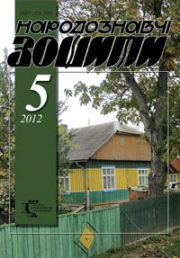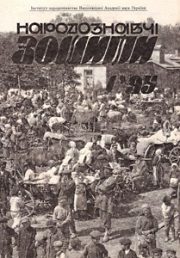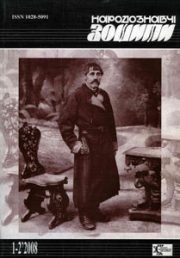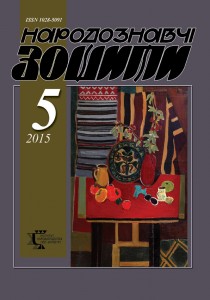2015 year, issue 5
In the early ХХth century the anthropological school formed in Lviv as part of the Shevchenko Scientific Society, which Ivan Rakovskyi also belonged to. During the First World War and the postwar period scholar interested in issues that concerned the Ukrainian anthropological traits. Upon learning memoirs of Shevchenko’s contemporaries, his death mask and self-portraits, as well as other sources, in 1921, the researcher described the general poet’s appearance and defined his typical anthropological traits.
Keywords: Ivan Rakovskyi, Taras Shevchenko, anthropological features.
Keywords: Ivan Rakovskyi, Taras Shevchenko, anthropological features.
A paper presents a detailed folkloristic analysis of a narrative, which was told by a member of the insurgent armed underground about his staying with the Metropolitan J. Slipyj in common cell of Zolochiv prison. The narrator in the mainstream of insurrectional epic tradition depicts Metropolitan-prisoner realistically and historically from the one hand, and simultaneously idealizes him as national hero of the new times — the outstanding figure of the Ukrainian Church and the entire state.
Keywords: Joseph Slipyj, Greek Catholic Church, Baptists, insurrectional epic tradition, prayer in crisis, small prison society, psycho-emotional climate in prison cell, morality and food in a prison cell.
Keywords: Joseph Slipyj, Greek Catholic Church, Baptists, insurrectional epic tradition, prayer in crisis, small prison society, psycho-emotional climate in prison cell, morality and food in a prison cell.
The paper analyses magical acts, which accompany definite agricultural works — plowing, sowing. All traditions and rites were performed very carefully, because the cropless was concerned with the uncorrect ritual acting, but not with the bad weather conditions.
Keywords: folk calendar, plowing, sowing, early spring corns.
Keywords: folk calendar, plowing, sowing, early spring corns.
The paper investigates some peculiarities of application of traditional magic defencive methods for live-stock among Boykos’; the attention is paid to the demonological notions of highlanders about close connection of domestic animals and the house spirits; the main methods of protecting the live-stock from witch-bosurkanya are analyzed.
Keywords: house spirits, live-stock, witch, «bosurkanya», Boyky.
Keywords: house spirits, live-stock, witch, «bosurkanya», Boyky.
Divination rite of «sowing hemp», which existed in the different ethnographic regions of Ukraine, is analyzed. In particular, its semantics, symbolics, functions, archaic elements and local versions are examined.
Keywords: divination, corn, sowing, oracular dream, counting.
Keywords: divination, corn, sowing, oracular dream, counting.
Radovych Roman. A bread trough in the interior of Polissya dwelling. P. 1045
The features of equipping of «pokutj» — south-eastern angle in Polissya dwelling, which according to its sacral and symbolic value took a special place, are reviewed. The attention is paid to the single objects, which were situated in that part of a dwelling cell (table, icons, towels etc.). In particular, a bread trough is examined as an element of the interior: its place in a house, ways of producing, functioning in calenfar and family rituality, divination, rites etc.
Keywords: Polissya, house, interior, table, icons, tough.
Keywords: Polissya, house, interior, table, icons, tough.
Taras Viktoriya. The interplays betweeen baroque types of buildings and landscape closings. P. 1054
The main types of secular baroque buildings, which included the landscape complexes, are reviewed. The analyses of spatial, planning and compositional interplays between secular baroque buildings and the landscape complexes crystallized general principles of their location.
Keywords: landscape art, baroque, city palace, suburban palace, out-of-town castle, out-of-town palace, homestead.
Keywords: landscape art, baroque, city palace, suburban palace, out-of-town castle, out-of-town palace, homestead.
The artistic features in the architecture of railway stations in Ukraine of the second half of the XIX — first third of the XX centure are analyzed. According to the example of concrete memorials, the specific features of such styles, as eclectisism, modern, art deco are detected, as well as the principles of combination of retrospective direction with advanced building technologies in the architecture of railway stations.
Keywords: architecture of railway stations, artistic and stylistic features, retrospective direction, eclectisism, modern, art deco, ornamental architectural details, synthesis of arts.
Keywords: architecture of railway stations, artistic and stylistic features, retrospective direction, eclectisism, modern, art deco, ornamental architectural details, synthesis of arts.
Gerus Lyudmyla. The folk toy of Pokuttya. P. 1072
On the basis of studying the collection from the Museum of ethnography and art craft in the Institute of ethnology of NAS Ukraine, and the analyses of field and archive materials, the history of folk toy of Pokuttya is shown in the paper; trends of development and decline during the 1910—2010 years and its artistic and functional features are also reviewed.
Keywords: folk toy, game, function, plastic, form, color, décor.
Keywords: folk toy, game, function, plastic, form, color, décor.
On the basis of collected field materials, available sources and scientific literature, hewn motionless bench as the archaic type of the folk furniture for sitting in the interior of peasant dwelling is briefly analyzed. Time of nascence, material, sizes, form, versions of constructive connections, functional purpose are traced. The material mainly represents two regions of Ukraine — Ukrainian Carpathians (Boykivshchyna, Huculshchyna, Lemkivshchyna) and Central Polissya (watershed of Uzh and Teteriv).
Keywords: Ukraine, Ukrainian Carpathians, Boykivshchyna, Huculshchyna, Lemkivshchyna, Central Polissya, folk furniture, pave, hewn bench, constructive connections.
Keywords: Ukraine, Ukrainian Carpathians, Boykivshchyna, Huculshchyna, Lemkivshchyna, Central Polissya, folk furniture, pave, hewn bench, constructive connections.
Ivashkiv Halyna. Small plastic art forms in the interior. P. 1099
The article analyzes small earthenware plastic art forms, namely figures of birds and animals, mythological and Christian images, sculptural portraits, genre and everyday life compositions. Small plastic art forms mainly performed the decorative function in the interior. The author of the article has examined earthenware plaques, busts and monuments to Taras Shevchenko, images of potters, a bride and a groom as well as processions and scenes describing customs and traditions, work in the field or various grotesque compositions. Artistic specificity of these items has been highlighted.
Keywords: small plastic art forms, figure, sculpture, interior, premises, function, decor, craftsman.
Keywords: small plastic art forms, figure, sculpture, interior, premises, function, decor, craftsman.
The typological and artistic features of crocheted lace and knitting of Boykivshchyna and Pidgirya region in the late XIX — the beginning of XXI century are reviewed in the paper. The local features, the main types of apparel products, their existence and extent of spread are analyzed. The respondent information was implicated, and the artifacts, recorded during the field research, were put into circulation.
Keywords: knitting, lace, hook, hats, decoration, local features, typology.
Keywords: knitting, lace, hook, hats, decoration, local features, typology.
A theme, that was started in the previous collection, is illuminated. The clothes jewellery of the population of Kievan Rus are investigated. They can be grouped according to such purpose, as: for head, breast, belt, hands. Single parts are represented by the symbolic elements, which added the clothes of secular and ecclesiastic persons, and the ammunition of horseman. It is emphasized, that the character of jewellery denoted a social, sexual and age-old status of concrete person.
Keywords: Kievan Rus, jewellery, mound disposal, relicts of old Kievan Rus writing.
Keywords: Kievan Rus, jewellery, mound disposal, relicts of old Kievan Rus writing.
Research of theatrical costume in Ukraine as professional art is investigated in the paper. Studies of philosophy and art criticism scholars are analyzed. The actuality of the research of theatrical costume is justified.
Keywords: the theatrical costume, scenography, art of avangarde, aethetics.
Keywords: the theatrical costume, scenography, art of avangarde, aethetics.
The article presents a historical art study of the iconostasis of the Ukrainian Catholic Cathedral of the Holy Family in London, carried out for the first time. Yuvenaliy Mokrytskyj, a famous Ukrainian artist-iconographer and a priest of the Studite Brethren, made the iconostasis in 1987—1992. So far, art historians have not mentioned this outstanding artistic work of the master in academic literature. The article is based on the materials of the author’s personal researches during her visit to London in August 2013. The photo of the iconostasis and the icons are published for the first time.
Keywords: Ukrainian Catholic Cathedral of the Holy Family in London, iconostasis, icons, iconography, oil technique, canonical features, style innovation, Ukrainian neobyzantism.
Keywords: Ukrainian Catholic Cathedral of the Holy Family in London, iconostasis, icons, iconography, oil technique, canonical features, style innovation, Ukrainian neobyzantism.
English satirical drawings of the late XVIII — XIX centuries — striking phenomenon of European art from the period of acute social conflicts, social struggles and wars. A Creativity of English caricaturists of this period largely characterizes the features of the development of English fine art, and its originality. The collection of English satirical drawings of the late XVIII — early XIX centuries from the funds of Kharkiv Art Museum is studied in this paper for the first time. Individual peculiarities of artistic manner of famous English caricaturists, and the relevance of their skills in today’s Ukrainian reality are analyzed.
Keywords: English art, political caricature, satirical drawings, grotesque.
Keywords: English art, political caricature, satirical drawings, grotesque.
The paper describes Transcarpathian Painting of the XXI century, which demonstrates the relentless search of the artists for new, contemporary expressive means, that historically formed two trends. The artistic pictorial language of transavantgarde artist Lovrant Bokotey is analyzed. A decoding of some postmodern concepts is given here. Some periods in the art of Lovrant are being described and the artist’s artistic formula is being explained, which is abbreviated as «MIMIKA».
Keywords: vanguard, transavantgarde, transgression, ethical dimension, asthenosphere, cosmization.
Keywords: vanguard, transavantgarde, transgression, ethical dimension, asthenosphere, cosmization.
Hridyayeva Tamara. Land art in Ukraine during the 1980s — first half of 2000s. P. 1181
The article is dedicated to timing analysis of practical manifestations of the environments, objects-installations and actions in the environment as the first attempts to create land art in Ukraine. The study identified the main aspects of the development of land art in dynamics during the 1980s — 2000s in the context of Ukrainian actionism art. Theoretical and visual experiences were basically used, and systematization of author’s projects was carried out.
Keywords: environment, object in the environment, action in the environment, installation in the environment, Ukrainian land art.
Keywords: environment, object in the environment, action in the environment, installation in the environment, Ukrainian land art.
The article is presenting and methodizing the traditional and the modern trends of the creational and organizational activities of the Order of Merit of the Donetsk Regional Academic Russian Drama Theatre of Mariupol town in times of hostilities (1914—1920, 1941—1945, 2014). The authors define the main periods in the history of the theater, related to the hostilities, characterize the trends in the creational and organizational activities of the theater in the context of military and historical events in the region, clarify the main repertoire of the theater and language policy in times of war.
Keywords: Donetsk Academic Order of Merit Regional Russian Drama of Mariupol Theatre, hostilities 1914—1920, 1941—1945, 2014, repertoire, touring activity.
Keywords: Donetsk Academic Order of Merit Regional Russian Drama of Mariupol Theatre, hostilities 1914—1920, 1941—1945, 2014, repertoire, touring activity.
Kosiv Vasyl. Ukrainian surrealism in graphic design of variety posters of 1970—1980-ies. P. 1202
The article deals with examples of surrealism in graphic design of Ukrainian variety posters in the 1970—80-ies. Non-acceptable in Soviet fine arts, this style is represented with two directions in Ukrainian variety poster. The first one created an illusion of a new reality with unexpected and chaotic combinations of realistic images, following the works of Rene Magritte and other famous surrealists. The second one was aligned with coextensive examples from Polish and Czech poster artists, encoding important social messages with metaphors. Combination of traditional folk motives with the stylistic of popular Western movement created a «modernity» connotation for the Ukrainian culture.
Keywords: graphic design, Ukrainian variety poster, vocal and instrumental ensembles, surrealism, marvelous, uncanny, metaphor.
Keywords: graphic design, Ukrainian variety poster, vocal and instrumental ensembles, surrealism, marvelous, uncanny, metaphor.
On the basis of the field ethnographic materials the author described a ponderable component of house dwelling rituals of Volynians — house warming traditions. Beliefs about the timing options of «vkhishchyna» were examined. The author investigated ritual ways to avoid demonological danger in new house. The funeral motives of ritual repast were defined, as well as the demonological beliefs in the context of reviewed rituality.
Keywords: dwelling rituals, house warming, Volyn, customs, rituals, beliefs.
Keywords: dwelling rituals, house warming, Volyn, customs, rituals, beliefs.
Koval Andriy. Church painting of Kornylo Ustyyanovych: dentification of one icon. P. 1228
We are talking about the painter Kornylo Ustyyanovych’s legacy, a significant part of which consists of Christian themes. For the first time in the art studying the analysis of icon «Christ’s Changing» is presented, which was found in the Volosyanka village Skole district, Lviv region’s church. The relationships between the priest families of Ustyyanovychs and Revakovychs, in particular, between the Kornylo and Tyt, are researched. In addition, the artist depicted the portrait of Tyt still at a young age.
Keywords: Christ’s Changing, technique of art, tint, portrait.
Keywords: Christ’s Changing, technique of art, tint, portrait.
Sokil Vasyl. The unknown period of pastoral activity of mitrat Oleksiy Bazyuk. P. 1233
The occasions from life and work of mitrat O. Bazyuk are reviewed. The objective biographical information, based on archival sources and materials from the personal file of the priest, is presented. Due to the metric church books with entries of Volosyanka village, which were led by O. Bazyuk during the 1945—1948 biennium., this segment of his work in the parish is firstly presented. Attention is paid to the completeness and exhaustive information about the congregation, even of those killed in combat during the UPA period. Time and place of priest’s burial is investigated.
Keywords: personal record, metric records, mitra, posokh.
Keywords: personal record, metric records, mitra, posokh.
As a result of the examination of rocky outcrops near the vil. of Yamel’nytsya, Skole district of Lviv region, made by the State Historical and Cultural Park «Tustan’» new petroglyph — the cross with twelve tips — was discovered. Similar crosses are known at the medieval Christian monuments in Crimea and Bulgaria (Preslav).
Keywords: petroglyphs, twelvetipped cross, The State Historical and Cultural Park «Tustan’».
Keywords: petroglyphs, twelvetipped cross, The State Historical and Cultural Park «Tustan’».
Domorad Iryna. Ukrainian folk culture in Canada – vision of Robert-Bogdan Klymash. P. 1242








